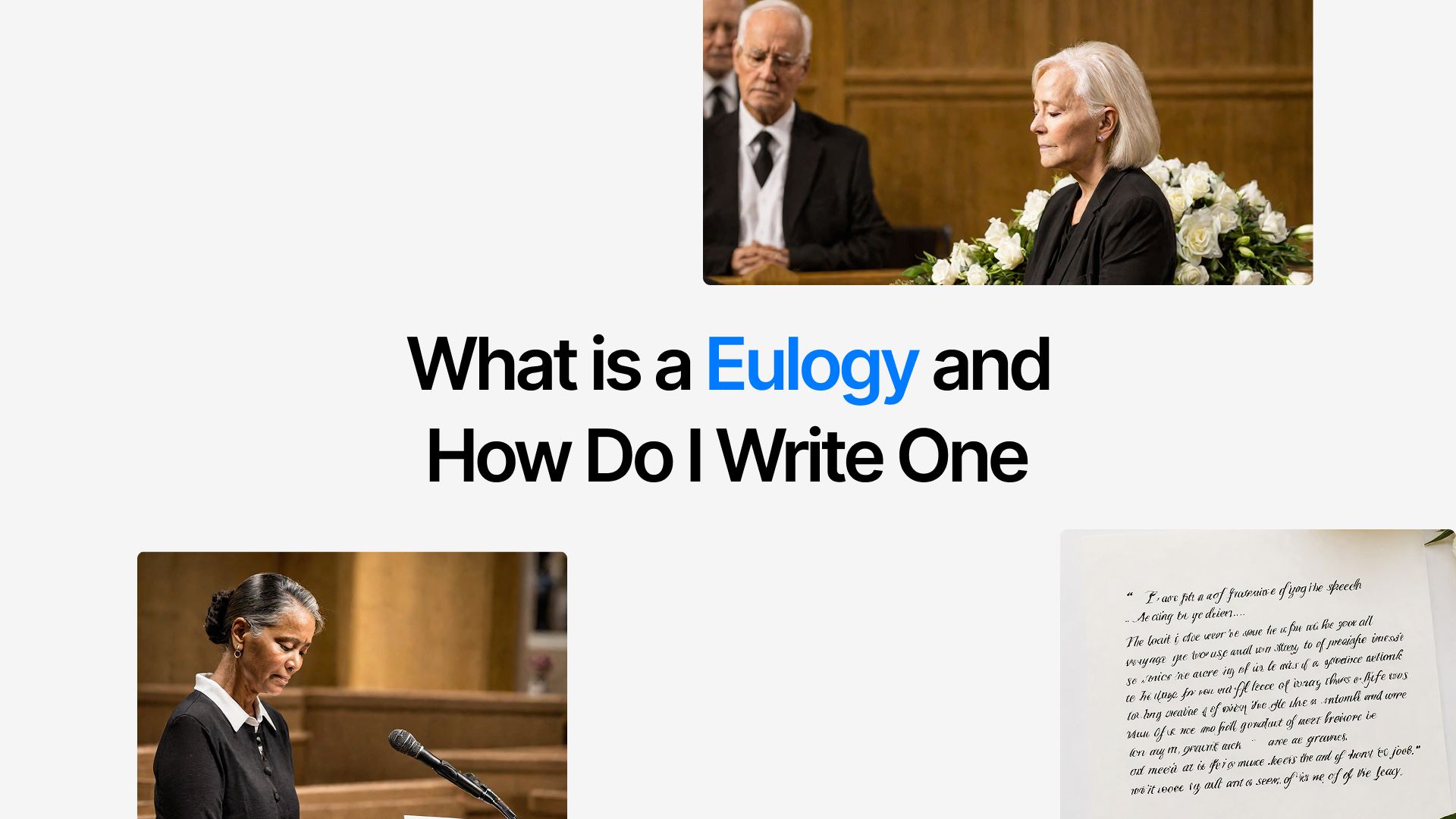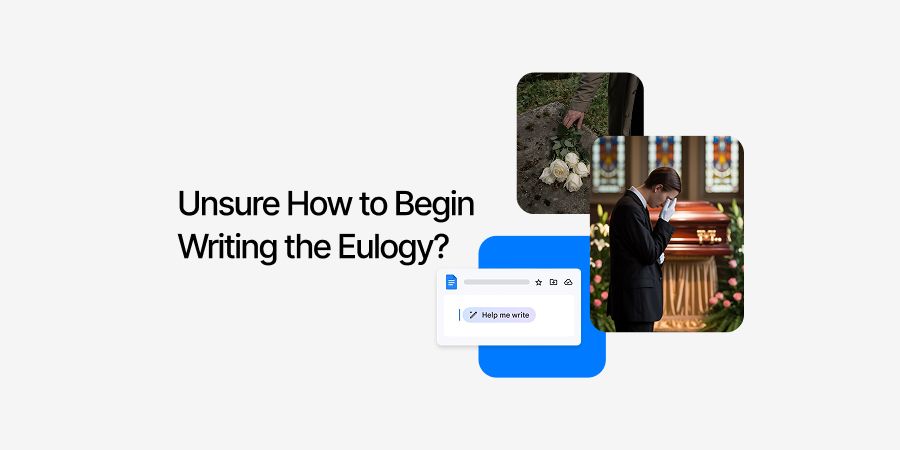
What is a Eulogy and How Do I Write One
A eulogy can feel like a huge responsibility, but it doesn’t have to be overwhelming. With some structure and a few simple ideas, anyone can write one that feels honest, personal, and meaningful.
This guide will explain what a eulogy is, why it matters, and how you can write one that reflects the life of the person you are honoring.
What is a Eulogy
There are no strict rules for what a eulogy should sound like. Some are formal and short. Others are full of personal anecdotes, humor, and details that bring the person’s character to life. What matters most is that the words are genuine.
A eulogy should reflect the person as they truly were, whether that means telling serious stories of achievement or recalling the funny quirks that everyone remembers with a smile.
Why a Eulogy Matters
The eulogy is often the most personal part of a funeral. It is a way to bring the voice of the deceased back into the room for a moment. It can comfort people, remind them of memories they may have forgotten, and give them a chance to see the person in new ways.
How to Write a Eulogy
Facing a blank page is the hardest part.
Many people feel pressure to summarize an entire life in a few minutes, and the weight of that task can be intimidating. The truth is, there is no perfect way to write a eulogy. What matters most is that it comes from an honest place and feels true to the person you are remembering.
It’s also helpful to keep the audience in mind. A eulogy is written for the people listening as much as it is for the one being honored.
Imagine how friends, family members, and colleagues might connect to the stories you choose. The best eulogies bridge those different perspectives into one collective memory.
There’s no single format, but a few guiding steps can make the process easier:
- Start with a simple introduction of who you are and your relationship to the deceased.
- Share one or two meaningful stories or experiences.
- Highlight qualities, values, or achievements that defined them.
- End with a short reflection or farewell.
Keeping this loose structure in mind can turn a daunting task into something manageable.
Funeral Speech vs Eulogy
People often use the terms interchangeably, but there are subtle differences worth noting. Both are spoken at funerals, both honor the deceased, and both aim to comfort those gathered. The distinction comes from focus and scope.
A eulogy is usually personal. It is written and delivered by someone who knew the person well – a child, sibling, friend, or close colleague. It centers on stories, habits, qualities, and memories.
The tone is intimate, often conversational, and the goal is to help the audience remember the life that was lived.
A funeral speech, on the other hand, can be broader. It might be delivered by a celebrant, religious leader, or another figure guiding the ceremony. In addition to tribute, it may include reflections on the meaning of life and death, readings, prayers, or cultural rituals.
Where the eulogy is deeply personal, the funeral speech often holds the ceremony together.
Shared ground:
- Both mark respect for the deceased.
- Both use storytelling and reflection.
- Both give comfort through memory and acknowledgment.
Key difference:
- A eulogy is personal testimony.
- A funeral speech blends tribute with ceremony.
Knowing the difference helps you prepare. If you’re asked to give a eulogy, focus on personal stories. If you’re asked for a funeral speech, include tribute but also be ready to support the flow of the service.
Eulogy Examples for Inspiration
Reading examples helps take the pressure off. They show you different ways to shape a tribute, and you can choose the one that feels closest to the life you’re honoring. Below are several common patterns you can adapt.
Chronological Tribute
Follow the person’s life from beginning to end.
Structure:
- Start with who you are and your relationship.
- Share one detail from childhood.
- Move through milestones (school, work, relationships).
- Highlight defining qualities that run through their life.
- End with how they are remembered today.
Best for: People with clear milestones and a strong life story arc.
Anecdote-Led Portrait
Let a few memorable stories carry the speech.
Structure:
- Open with a single vivid story.
- Add two or three short scenes from different stages of life.
- Point out the trait these moments reveal.
- Close with gratitude or farewell.
Best for: Lives defined more by moments than milestones.
Value-Driven Eulogy
Organize the speech around the person’s values.
Structure:
- Choose three values (for example: kindness, humor, perseverance).
- Share one story for each value.
- Connect those values to how they treated people.
- End by encouraging others to carry those values forward.
Best for: People remembered most for principles and character.
Light-Hearted but Respectful
Blend humor with warmth.
Structure:
- Start with a light anecdote everyone recognizes.
- Follow with a heartfelt observation.
- Close by returning to gratitude and respect.
Best for: People whose humor was central to their personality.
Collective Voice
Bring in multiple perspectives.
Structure:
- Introduce the theme of the tribute.
- Include short lines or quotes from family and friends.
- Add your own story that ties everything together.
- Finish by thanking everyone for their contributions.
Best for: Honoring someone with many close relationships.
Celebrant-Delivered Eulogy
Write it for someone else to read aloud.
Structure:
- Open with a simple identity statement.
- Add three short vignettes.
- Summarize key qualities and impact.
- Close with a reflective or inviting note (poem, lyric, moment of silence).
Best for: Families who prefer a composed, steady delivery.
How to Use These Eulogy Examples Without Losing Your Voice
- Look at structure, not wording. Replace examples with your own memories.
- Keep it to about five minutes; trim repetition.
- Focus on one or two details per story.
- Match the tone to the person’s character.
- End simply with thanks or a reflection.
What to Include in a Eulogy
Knowing what to put in a eulogy can be overwhelming. You don’t need to capture every part of someone’s life. What matters is choosing details that feel true and meaningful. Think of the speech as a highlight reel, not a complete biography.
Here are elements you can include to make the tribute personal and memorable:
-
Personal Memories
-
Stories and Anecdotes
Stories make the person come alive in the minds of listeners. These can be funny, touching, or inspiring. Even small stories, a phrase they always said, a habit everyone knew add color.
-
Key Life Events
You don’t need a full timeline, but a few important milestones can give context. Childhood, education, career, marriage, or major achievements are natural anchors in a life story.
-
Passions and Hobbies
Talk about what they loved, it can be gardening, travel, sports, music, or anything that mattered to them. Hobbies often reveal personality and help people remember the joy in someone’s life.
-
Work and Achievements
If work was central to who they were, include a note about their career or professional values. Focus less on titles and more on what they contributed or how they were known in that role.
-
Poems, Quotes, or Lyrics
Sometimes a short poem, reading, or line from a song captures what you want to say better than your own words. Choose something that reflects their outlook or personality.
-
Character and Values
Summarize qualities that defined them: kindness, resilience, humor, loyalty. Naming these traits gives everyone a lens through which to remember them.
-
Words of Farewell
A closing line that thanks them, expresses love, or invites the audience to remember them in a certain way gives the eulogy a strong finish.
Tips for Writing a Strong Eulogy
Writing a eulogy is not about perfection. It’s about capturing a life in words that feel natural, respectful, and true. Here are practical tips that make the process easier and the speech more effective.
-
Speak From the Heart
Use your own voice. Formal language or overly polished phrases can make the speech sound distant. Simple, sincere words resonate more than trying to impress.
-
Keep It Conversational
Imagine you are talking to a room of friends. Write in short sentences. Avoid complicated wording. A conversational tone feels warmer and more genuine.
-
Match the Tone to the Person
If the person loved humor, a funny story can be the perfect tribute. If they were formal or reserved, keep the tone measured. Let their character guide your choices.
-
Ask Others for Memories
-
Create a Simple Outline First
Sketch the structure before filling it in. Begin with an introduction, move into stories and qualities, and close with reflection. This makes the writing process easier and keeps you on track.
-
Write in Plain English
Short sentences are easier to read aloud and easier for the audience to follow. Avoid flowery or complex language, it doesn’t add impact, it only distracts.
-
Practice Reading Out Loud
Reading your draft aloud shows you where sentences are too long or where the tone feels off. It also helps with timing. Aim for around five minutes, but adjust to what feels natural.
-
Focus on Meaning, Not Length
A short, heartfelt eulogy will be remembered far more than a long one filled with details no one connects to. Concentrate on impact rather than trying to cover everything.
Common Mistakes to Avoid in a Eulogy
Even with the best intentions, some tributes lose their impact because of simple missteps. Knowing what to avoid makes your words clearer and more meaningful.
-
Turning It Into a Diary
A eulogy is not a personal journal entry. Avoid long, overly private reflections that only you understand. Focus instead on stories and moments that others can also connect to.
-
Forgetting Ethical Boundaries
-
Overloading With Information
Trying to cover every detail of a person’s life often weakens the message. A few specific moments told well are more powerful than a long list of facts.
-
Using Language That Feels Unnatural
Complicated words or overly formal phrasing make the tribute sound distant. Speak as you normally would. Plain, clear language has the most impact.
-
Losing Balance Between Emotion and Professionalism
Eulogies should show emotion, but avoid letting grief overwhelm the speech. On the other side, don’t make it sound clinical or detached. Aim for balance: respectful, heartfelt, and steady.
How Chatly Can Help Write a Eulogy
Writing a eulogy often feels like more than just writing. It’s emotional, time-sensitive, and loaded with the fear of “getting it right.” That pressure makes it harder to put words on the page.
Chatly AI Chat can ease that process without replacing your voice. It works like a writing partner – organizing thoughts, polishing tone, and guiding you toward a finished tribute that feels true.
Here’s how it helps:
- Organize scattered notes into structure – Jot down memories, traits, or short stories and let Chatly arrange them into a flowing draft.
- Refine the tone – Adjust between warm, conversational, or formal, depending on what fits the person’s character best.
- Suggest where to add depth – Highlight spots where anecdotes, quotes, or values could enrich the story.
- Save time when words feel stuck – Instead of staring at a blank page, start with a draft you can shape.
- Create reusable outlines – If you need to write for multiple speakers or occasions, Chatly makes it simple to adapt one structure into another.
Grief makes writing heavy. Chatly doesn’t take that away, but it does make sure you aren’t carrying the burden alone.
If you want a tool that gives you a draft to build on and the confidence that nothing is missing, sign up for Chatly today and turn hesitation into progress.
Conclusion
A eulogy is never about perfection. It is about honesty, respect, and memory. When written with care, even simple words can bring comfort and meaning to everyone listening.
The process is not complicated. You need only to:
- Choose details that reflect the person truly.
- Balance personal stories with broader qualities.
- Keep the language plain and natural.
Suggested Reads
Frequently Asked Questions
Top trending questions related to writing a eulogy.
More topics you may like

How to Write a Brand Collaboration Proposal in 2025

Muhammad Bin Habib

How to Write a Bulk Sales Request to a Buyer

Muhammad Bin Habib

How to Write a Case Report in 2025

Muhammad Bin Habib

How to Write a Case Study, with Examples, Tools and Templates

Muhammad Bin Habib

How to Write a Complaint Letter to a Hospital

